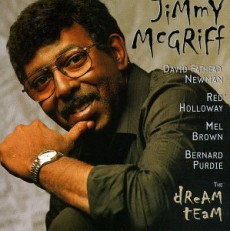
Daily Dose Of Jazz…
Jimmy McGriff was born James Harrell McGriff on April 3, 1936 in Germantown, Pennsylvania and started playing piano at the age of five. By his teens he learned to play vibes, alto saxophone, drums and upright bass. His first group was as bassist in a piano trio. When he joined the United States Army he served as an MP during the Korean War, later became a police officer in Philadelphia for two years.
Music kept drawing McGriff’s attention away from the police force. His childhood friend, Jimmy Smith began earning a substantial reputation and he became entranced by the organ sound while Richard Groove Holmes played at his sister’s wedding. Holmes went on to become his teacher and friend.
Buying his first Hammond B-3 organ in 1956, spent six months learning the instrument, and then studied at New York’s Juilliard School. Influenced by Count Basie, Howard “The Demon” Whaley, Austin Mitchell and Milt Buckner with whom he studied privately and as well with Jimmy Smith and Sonny Gatewood.
Forming a combo Jimmy played around Philadelphia often featuring tenor saxophonist Charles Earland, who soon switched to the instrument. During this time, McGriff also accompanied such artists as Don Gardner, Arthur Prysock, Candido and Carmen McRae, who came through town for local club dates.
In 1961, McGriff’s trio recorded an instrumental version of Ray Charles’ hit “I Got A Woman” for Jell Records, and after the record received substantial local airplay, Sue Records picked it up and recorded a full album of McGriff’s trio, released in 1962. The album established his credentials as a fiery blues-based organist, well versed in gospel, soul and “fatback groove”.
McGriff would recorded a series of popular albums by the mid Sixties ending with what still stands as one of his finest examples of blues-based jazz, Blues for Mister Jimmy. Over the next decade he went on to continue recording for Solid State, opened his own supper club “The Golden Slipper” in Newark, New Jersey and performed regularly performed with the Buddy Rich Band.
Though he retired from the music industry in 1972 to start a horse farm in Connecticut his records were being issued at three to four a year by Sonny Lester’s Groove Merchant label. By 1973, Jimmy was touring relentlessly and actively recording again and though disco was gaining a hold it did little to stop the organist. He produced some of his best music during this period: Stump Juice, Red Beans and Outside Looking In.
The 1980s saw McGriff working with Rusty Bryant, Al Grey, Red Holloway, David “Fathead” Newman, Frank Wess and Eric Alexander, and started a longtime partnership with Hank Crawford. Into the new millennium he experimented with the Hammond XB-3 and organ synthesizer with Midi enhancements. Along with his soul jazz sound, forming the Dream Team group he recorded and released his last album, McGriff Avenue in 2001.
On May 24, 2008 at the age of 72, hard bop and soul jazz organist and bandleader Jimmy McGriff, who left a catalogue of 57 albums to posterity, passed away in Voorhees Township, New Jersey from complications due to multiple sclerosis.
More Posts: organ


